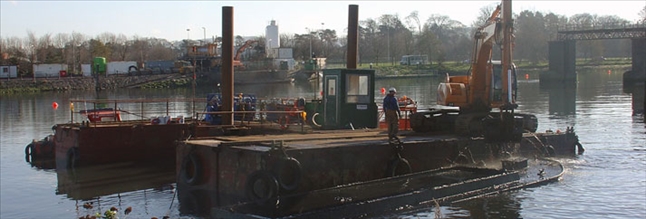
Doran Consulting was commissioned by Laganside Corporation to act as lead consultant for this major maintenance dredging and environmental improvement scheme, on the River Lagan, Belfast.
After a series of detailed hydrographic surveys of the river it was evident that an extensive programme of dredging was required in order to maintain the navigable depth. The areas where siltation had occurred were identified and the material to be dredged tested chemically so that the appropriate means of safe disposal could be determined.
After extensive detailed discussions with the Environmental Protection Division of the Environment and Heritage Service and the Fisheries Division of the Department of Agriculture and Rural Development, it was decided to programme the works so that dredging would not be carried out between the months of May and September when migratory fish runs occur. During this period, low river flow conditions and higher water temperatures combine to cause a reduction in water quality, particularly the dissolved oxygen content that is an important factor in sustaining aquatic life. There was the additional concern that sediment disturbed during dredging would be potentially damaging to fish life. By taking this approach together with good dredging practice to minimise suspended sediment, the works were successfully completed with no damage to the aquatic environment.
The contractor for this phase of the works was Seastructures Ltd. Approximately 70,000 tonnes of silt were dredged from the upper reaches of the impounded section of the river and disposed of at sea under licence issued by the Environmental Heritage Service. The spoil material was transported down the river from the dredge site on small barges and transferred to a large sea-going barge for careful discharge at sea. This avoided the need for numerous lorry movements of wet silt along narrow city streets with the associated disruption to local river side communities.
The second phase of the works was carried out by DEC Environmental Contractors. This involved dredging approximately 20,000 tonnes of contaminated material from the area around the Blackstaff Culvert and site of the former gasworks. The dredged material, which was contaminated with PCBs, was treated in a specially constructed on-site treatment facility at Ravenhill Reach slipway before being transported by sealed lorry for disposal to a licensed landfill site.